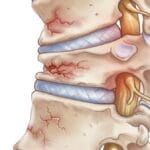Luckily, there are simple remedies
If you sit at a desk all day, you may experience vague discomfort and pain where you sit. Doctors may call this lower cross syndrome, gluteal amnesia or gluteus medius tendinosis.
But another more memorable term is: “dead butt” syndrome.
When I call it ‘dead butt’ syndrome, patients grasp the concept right away. I didn’t coin the phrase, but I like to use it because it’s easy to understand.
In this syndrome, muscle tightness and weakness combine to create an imbalance. Constant sitting weakens the gluteus medius, one of the three primary muscles in the buttock. It also tightens the hip flexors.
The job of the gluteus medius is to stabilize your hips and pelvis. When it’s weak and can’t function properly, you may experience varying levels of hip and lower back pain when you sit and sometimes when you move.
“Muscle weakness can also compress, pull or pinch the nerves, leading to the numbness related to dead butt syndrome.
What causes ‘dead butt’ syndrome?
Not surprisingly, sitting for long periods in front of a desk or in a car is the most common cause of dead butt syndrome.
The weakness is gradual, happening over time. Most patients have no idea what they did to cause the pain.”
But the problem also strikes those who are active. Athletes, especially avid runners who forgo cross-training and strength training, can also develop this syndrome.
Can you feel better without resorting to pain medication or surgery? Most definitely.
Simple exercises that help
A deep tissue massage can sometimes help combat the problem. But three exercises will often help you conquer the pain and discomfort:
1. Side-lying leg lifts
Repeat 15 to 20 times, in sets of three, every day:
- Lie down on your right side.
- Lift your left leg with your big toe pointing toward the floor, and lift.
- Repeat on your left side, lifting your right leg. Once you are comfortable doing this exercise regularly, you can work with a band or an ankle weight for extra resistance.
2. Clamshell
Repeat 30 to 40 times, in sets of three, every day:
- Lie down on your right side with both knees bent.
- Keeping your feet touching, lift your bent left leg toward the ceiling.
- Repeat on your left side, lifting your bent right leg toward the ceiling.
3. Seahorse pose
This yoga pose, done while sitting on an armless chair, helps stretch your tight hip flexors. Hold the stretch for 20 seconds on each side, three times a day.
Simple changes that ward off pain
Making adjustments in how you work at your desk can also relieve dead butt syndrome — or prevent the problem before it develops.
For example, try sitting for 40 minutes and then standing for 20 minutes. Use the standing time to talk on the phone, do filing or confer with co-workers.
To make standing time even more flexible, using a sitting/standing desk. These adjustable-height desks come in two designs: a full-size desk or a table-top size that sits atop your traditional desk.
Some employers will purchase a sitting/standing desk for employees if they have a doctor’s order, It’s a very minimal expense, and a lot cheaper than paying for medical costs.
Even if your desk chair is ergonomically correct (conducive to good posture), it’s a good idea to change what you sit on periodically. This helps keep the muscles in your buttocks and lower back engaged.
A therapy ball, which lets you shift your weight easily and frequently, and a kneeling chair are both good options.





